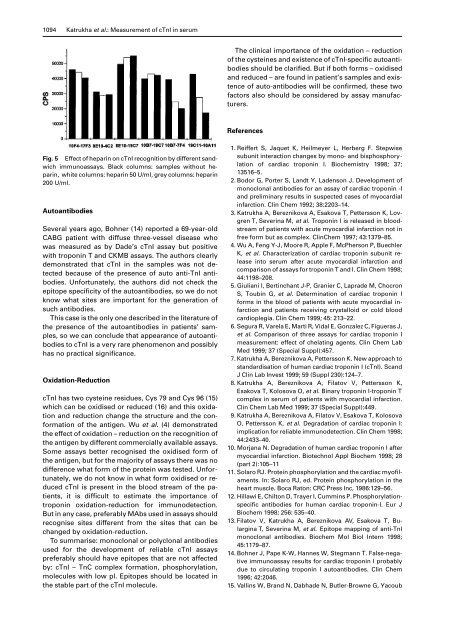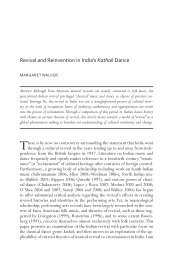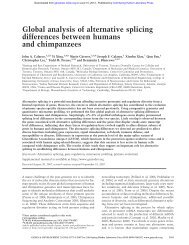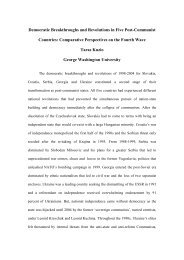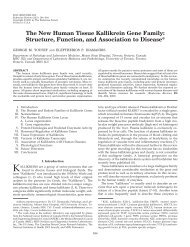Biochemical Factors Influencing Measurement of Cardiac Troponin I ...
Biochemical Factors Influencing Measurement of Cardiac Troponin I ...
Biochemical Factors Influencing Measurement of Cardiac Troponin I ...
Create successful ePaper yourself
Turn your PDF publications into a flip-book with our unique Google optimized e-Paper software.
1094 Katrukha et al.: <strong>Measurement</strong> <strong>of</strong> cTnI in serumThe clinical importance <strong>of</strong> the oxidation – reduction<strong>of</strong> the cysteines and existence <strong>of</strong> cTnI-specific autoantibodiesshould be clarified. But if both forms – oxidisedand reduced – are found in patient’s samples and existence<strong>of</strong> auto-antibodies will be confirmed, these tw<strong>of</strong>actors also should be considered by assay manufacturers.ReferencesFig. 5 Effect <strong>of</strong> heparin on cTnI recognition by different sandwichimmunoassays. Black columns: samples without heparin,white columns: heparin 50 U/ml, grey columns: heparin200 U/ml.AutoantibodiesSeveral years ago, Bohner (14) reported a 69-year-oldCABG patient with diffuse three-vessel disease whowas measured as by Dade’s cTnI assay but positivewith troponin T and CKMB assays. The authors clearlydemonstrated that cTnI in the samples was not detectedbecause <strong>of</strong> the presence <strong>of</strong> auto anti-TnI antibodies.Unfortunately, the authors did not check theepitope specificity <strong>of</strong> the autoantibodies, so we do notknow what sites are important for the generation <strong>of</strong>such antibodies.This case is the only one described in the literature <strong>of</strong>the presence <strong>of</strong> the autoantibodies in patients’ samples,so we can conclude that appearance <strong>of</strong> autoantibodiesto cTnI is a very rare phenomenon and possiblyhas no practical significance.Oxidation-ReductioncTnI has two cysteine residues, Cys 79 and Cys 96 (15)which can be oxidised or reduced (16) and this oxidationand reduction change the structure and the conformation<strong>of</strong> the antigen. Wu et al. (4) demonstratedthe effect <strong>of</strong> oxidation – reduction on the recognition <strong>of</strong>the antigen by different commercially available assays.Some assays better recognised the oxidised form <strong>of</strong>the antigen, but for the majority <strong>of</strong> assays there was nodifference what form <strong>of</strong> the protein was tested. Unfortunately,we do not know in what form oxidised or reducedcTnI is present in the blood stream <strong>of</strong> the patients,it is difficult to estimate the importance <strong>of</strong>troponin oxidation-reduction for immunodetection.But in any case, preferably MAbs used in assays shouldrecognise sites different from the sites that can bechanged by oxidation-reduction.To summarise: monoclonal or polyclonal antibodiesused for the development <strong>of</strong> reliable cTnI assayspreferably should have epitopes that are not affectedby: cTnI – TnC complex formation, phosphorylation,molecules with low pI. Epitopes should be located inthe stable part <strong>of</strong> the cTnI molecule.1. Reiffert S, Jaquet K, Heilmeyer L, Herberg F. Stepwisesubunit interaction changes by mono- and bisphosphorylation<strong>of</strong> cardiac troponin I. Biochemistry 1998; 37;13516–5.2. Bodor G, Porter S, Landt Y, Ladenson J. Development <strong>of</strong>monoclonal antibodies for an assay <strong>of</strong> cardiac troponin -Iand preliminary results in suspected cases <strong>of</strong> myocardialinfarction. Clin Chem 1992; 38:2203–14.3. Katrukha A, Bereznikova A, Esakova T, Pettersson K, LovgrenT, Severina M, et al. <strong>Troponin</strong> I is released in bloodstream<strong>of</strong> patients with acute myocardial infarction not infree form but as complex. ClinChem 1997; 43:1379–85.4. Wu A, Feng Y-J, Moore R, Apple F, McPherson P, BuechlerK, et al. Characterization <strong>of</strong> cardiac troponin subunit releaseinto serum after acute myocardial infarction andcomparison <strong>of</strong> assays for troponin T and I. Clin Chem 1998;44:1198–208.5. Giuliani I, Bertinchant J-P, Granier C, Laprade M, ChocronS, Toubin G, et al. Determination <strong>of</strong> cardiac troponin Iforms in the blood <strong>of</strong> patients with acute myocardial infarctionand patients receiving crystalloid or cold bloodcardioplegia. Clin Chem 1999; 45: 213–22.6. Segura R, Varela E, Marti R, Vidal E, Gonzalez C, Figueras J,et al. Comparison <strong>of</strong> three assays for cardiac troponin Imeasurement: effect <strong>of</strong> chelating agents. Clin Chem LabMed 1999; 37 (Special Suppl):457.7. Katrukha A, Bereznikova A, Pettersson K. New approach tostandardisation <strong>of</strong> human cardiac troponin I (cTnI). ScandJ Clin Lab Invest 1999; 59 (Suppl 230):124–7.8. Katrukha A, Bereznikova A, Filatov V, Pettersson K,Esakova T, Kolosova O, et al. Binary troponin I-troponin Tcomplex in serum <strong>of</strong> patients with myocardial infarction.Clin Chem Lab Med 1999; 37 (Special Suppl):449.9. Katrukha A, Bereznikova A, Filatov V, Esakova T, KolosovaO, Pettersson K, et al. Degradation <strong>of</strong> cardiac troponin I:implication for reliable immunodetection. Clin Chem 1998;44:2433–40.10. Morjana N. Degradation <strong>of</strong> human cardiac troponin I aftermyocardial infarction. Biotechnol Appl Biochem 1998; 28(part 2):105–1111. Solaro RJ. Protein phosphorylation and the cardiac my<strong>of</strong>ilaments.In: Solaro RJ, ed. Protein phosphorylation in theheart muscle. Boca Raton: CRC Press Inc, 1986:129–56.12. Hillawi E, Chilton D, Trayer I, Cummins P. Phosphorylationspecificantibodies for human cardiac troponin-I. Eur JBiochem 1998; 256: 535–40.13. Filatov V, Katrukha A, Bereznikova AV, Esakova T, BularginaT, Severina M, et al. Epitope mapping <strong>of</strong> anti-TnImonoclonal antibodies. Biochem Mol Biol Intern 1998;45:1179–87.14. Bohner J, Pape K-W, Hannes W, Stegmann T. False-negativeimmunoassay results for cardiac troponin I probablydue to circulating troponin I autoantibodies. Clin Chem1996; 42:2046.15. Vallins W, Brand N, Dabhade N, Butler-Browne G, Yacoub


